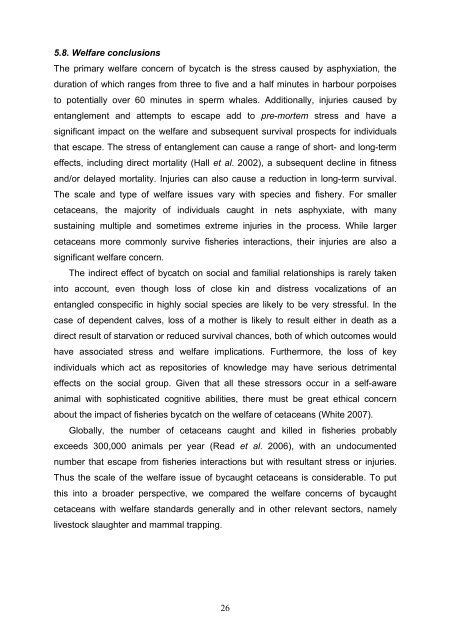The Animal Welfare Implications of Cetacean Deaths in Fisheries
The Animal Welfare Implications of Cetacean Deaths in Fisheries
The Animal Welfare Implications of Cetacean Deaths in Fisheries
You also want an ePaper? Increase the reach of your titles
YUMPU automatically turns print PDFs into web optimized ePapers that Google loves.
5.8. <strong>Welfare</strong> conclusions<br />
<strong>The</strong> primary welfare concern <strong>of</strong> bycatch is the stress caused by asphyxiation, the<br />
duration <strong>of</strong> which ranges from three to five and a half m<strong>in</strong>utes <strong>in</strong> harbour porpoises<br />
to potentially over 60 m<strong>in</strong>utes <strong>in</strong> sperm whales. Additionally, <strong>in</strong>juries caused by<br />
entanglement and attempts to escape add to pre-mortem stress and have a<br />
significant impact on the welfare and subsequent survival prospects for <strong>in</strong>dividuals<br />
that escape. <strong>The</strong> stress <strong>of</strong> entanglement can cause a range <strong>of</strong> short- and long-term<br />
effects, <strong>in</strong>clud<strong>in</strong>g direct mortality (Hall et al. 2002), a subsequent decl<strong>in</strong>e <strong>in</strong> fitness<br />
and/or delayed mortality. Injuries can also cause a reduction <strong>in</strong> long-term survival.<br />
<strong>The</strong> scale and type <strong>of</strong> welfare issues vary with species and fishery. For smaller<br />
cetaceans, the majority <strong>of</strong> <strong>in</strong>dividuals caught <strong>in</strong> nets asphyxiate, with many<br />
susta<strong>in</strong><strong>in</strong>g multiple and sometimes extreme <strong>in</strong>juries <strong>in</strong> the process. While larger<br />
cetaceans more commonly survive fisheries <strong>in</strong>teractions, their <strong>in</strong>juries are also a<br />
significant welfare concern.<br />
<strong>The</strong> <strong>in</strong>direct effect <strong>of</strong> bycatch on social and familial relationships is rarely taken<br />
<strong>in</strong>to account, even though loss <strong>of</strong> close k<strong>in</strong> and distress vocalizations <strong>of</strong> an<br />
entangled conspecific <strong>in</strong> highly social species are likely to be very stressful. In the<br />
case <strong>of</strong> dependent calves, loss <strong>of</strong> a mother is likely to result either <strong>in</strong> death as a<br />
direct result <strong>of</strong> starvation or reduced survival chances, both <strong>of</strong> which outcomes would<br />
have associated stress and welfare implications. Furthermore, the loss <strong>of</strong> key<br />
<strong>in</strong>dividuals which act as repositories <strong>of</strong> knowledge may have serious detrimental<br />
effects on the social group. Given that all these stressors occur <strong>in</strong> a self-aware<br />
animal with sophisticated cognitive abilities, there must be great ethical concern<br />
about the impact <strong>of</strong> fisheries bycatch on the welfare <strong>of</strong> cetaceans (White 2007).<br />
Globally, the number <strong>of</strong> cetaceans caught and killed <strong>in</strong> fisheries probably<br />
exceeds 300,000 animals per year (Read et al. 2006), with an undocumented<br />
number that escape from fisheries <strong>in</strong>teractions but with resultant stress or <strong>in</strong>juries.<br />
Thus the scale <strong>of</strong> the welfare issue <strong>of</strong> bycaught cetaceans is considerable. To put<br />
this <strong>in</strong>to a broader perspective, we compared the welfare concerns <strong>of</strong> bycaught<br />
cetaceans with welfare standards generally and <strong>in</strong> other relevant sectors, namely<br />
livestock slaughter and mammal trapp<strong>in</strong>g.<br />
26
















